World's second deepest Blue Hole discovered in Western Caribbean, will reveal many secrets of Earth's history
A blue hole has been discovered off the coast of the Yucatan Peninsula in Mexico, which is said to be the second deepest blue hole in the world. It is at a depth of 900 feet from the surface of the sea. Researchers believe that from this blue hole, we will know about the history of Earth and life on other planets.

The world's second deepest blue hole has been discovered off the coast of the Yucatan Peninsula in Mexico. This cave is under water in Chetumal Bay, at a depth of about 900 feet and is spread over an area of 147,000 square feet.
Let us tell you, the world's deepest blue hole is in the South China Sea, which is named Dragon Hole. It was discovered in 2016 and is believed to be more than 980 feet deep.
The blue hole is 900 feet below the surface and covers an area of 147,000 square feet (Photo: Alcérreca Huerta et al Frontiers in Marine Science)
Surprise discovery of world's 2nd deepest blue hole could provide window into Earth's history https://t.co/esMmay97HJ — Live Science (@LiveScience) April 21, 2023
What are blue holes?
First let us tell you what are blue holes. Blue holes can be called large sinkholes or vertical caves found under the sea, which are found in coastal areas. Many contain plants and marine life including coral, sea turtles and sharks.
The blue hole in Chetumal is named Taam Ja. It literally means deep water. These are steep sides with a slope of about 80 degrees and the mouth of the cave is about 15 feet below sea level.
It was first discovered in 2021 by scientists from El Colegio de la Frontera Sur (Ecosur), a public research center coordinated by Mexico's National Council of Science and Technology (Conacyt). The research related to this discovery has been published in the journal Frontiers in Marine Science.
How are blue holes made?
Blue holes are formed when sea water meets limestone. Limestone is very porous, so water easily penetrates the rock, causing chemicals in the water to react with the limestone and break it down.
Many of the world's blue holes are thought to have formed during the last ice ages, when repeated flooding and draining of coastal areas eroded rock and created voids.
When the last Ice Age ended about 11,000 years ago and sea levels rose, these caves were filled with water and some were completely submerged.
Blue hole will uncover the history of the earth
Blue holes are not easy to reach, so scientists have not been able to know about many of them. There is less oxygen in the blue hole and sunlight remains only on the surface.
Despite these conditions, this empty space is teeming with life, where organisms have adapted to the low-oxygen environment.
Researchers say blue holes can provide a snapshot of what life was like thousands of years ago. Without much oxygen and light, fossils can remain well preserved, allowing scientists to identify the remains of extinct species,
Blue holes can also give us information about life on other planets. In 2012, researchers peered into the Blue Hole in the Bahamas and found bacteria deep in the caves, where no other life existed.
Such results may provide clues to what kind of life might have existed in the harsh environment in our solar system.







